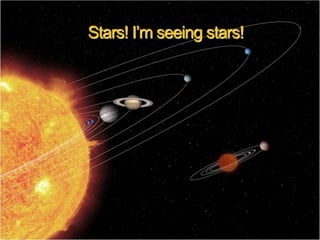
Notes stars
- 1. Stars! I’m seeing stars!
- 2. What IS a star anyway?!?! STARS: A star is a large ball of ionized gas, held together by gravity, that emits energy produced by nuclear reactions in its interior. Types of stars: Stars are classified by their size, temperature, and brightness!
- 3. Classifying Stars SIZE!!!! Temperature!!! Super Giant Hot = Red Red Giant Hotter = White Main Hottest = Blue/White Sequence Brightness! White Dwarf How bright it appears Neutron Star depends on it’s distance from us How bright it actually is depends on its size & temp.
- 4. Relationship between surface temperature and color of stars: 3,500 K 5,000 K 7,000 K 25,000 K (red) (yellow) (white) (blue) Just like car headlights You may notice at night look small and dim when you look up at the when they are far away stars that some seem and then BLIND you as to be slightly different they get closer, Stars colors, that has to do are similar. with their temperature!
- 5. Apparent vs. Absolute Apparent Magnitude Absolute Magnitude The observed The apparent luminosity of a celestial magnitude a star body, such as a star, as would have if it were observed from earth. 32.6 light years away The apparent from Earth. magnitude of a star depends on its luminosity and distance.
- 6. TOOLS OF ASTRONOMY Spectrograph: A tool that is used to obtain information from stars by breaking up the colors they emit.http://herschel.jpl.nasa.gov/farIRandSubmm.shtml
- 7. Chemical compositions: Each element absorbs different wavelengths of light and shows up as lines on a spectrum.
- 8. Temperature: Stars at different temperatures produce a different line spectra.
- 9. Distances to stars •Light Speed: Light travels at 300,000 km/s. •Light Year: The distance light travels in a year.